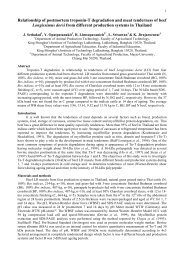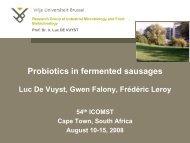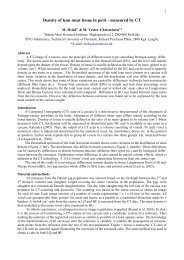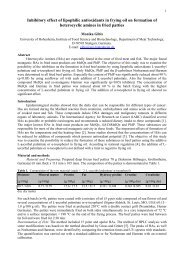Keizo Arihara
Keizo Arihara
Keizo Arihara
Create successful ePaper yourself
Turn your PDF publications into a flip-book with our unique Google optimized e-Paper software.
52nd ICoMST Dublin, Ireland<br />
18th August, 2006<br />
Strategies for designing novel<br />
functional meat products<br />
<strong>Keizo</strong> <strong>Arihara</strong><br />
Kitasato University, Japan
Kitasato University<br />
Functional Foods<br />
‘Processed foods having diseasepreventing<br />
and health-promoting<br />
benefits in addition to their<br />
nutritional value’<br />
Much attention has been paid to physiological<br />
functions of foods. Progress has been made<br />
in the development of functional foods, such<br />
as functional dairy products. However, ---
Kitasato University<br />
Functional meat products ?<br />
Many books on functional foods have been published.<br />
There has been little focus on meat and meat products.
Kitasato University<br />
Direction of meat products<br />
“The meat industry must adapt<br />
to the new concepts in nutrition.<br />
There is now a potential market<br />
for functional foods, based on<br />
the principle of added value<br />
linked to health benefits, which<br />
is one of the main trends in the<br />
development of food products.”<br />
CRC Press, 2006<br />
“New approaches for the development of functional meat products”<br />
(Chapter 11) Jiménez-Colmenero, Reig & Toldrá (2006)
Kitasato University<br />
n-3 fatty acids<br />
Nutritional and sensory properties<br />
of dry fermented sausages<br />
enriched with n-3 PUFAs<br />
Valencia et al.<br />
University of Navarra, Spain<br />
Meat Science, 72 : 727-733<br />
April 2006
Kitasato University<br />
Probiotics<br />
Potential probiotic Lactobacillus strains<br />
from fermented sausage: Further investigations<br />
on their probiotic properties<br />
Pennacchia et al.<br />
Università degli Studi di Napoli, Italy<br />
Meat Science, 73 : 90-101<br />
May 2006
Kitasato University<br />
Conjugated linoleic acid<br />
Factors influencing proportion and<br />
composition of CLA in beef<br />
De La Torre et al.<br />
INRA, France<br />
Meat Science, 73 : 258-268<br />
June 2006
Kitasato University<br />
Antioxidants<br />
Utilization of natural antioxidants:<br />
Green tea extracts and Thymbra spicata<br />
oil in Turkish dry-fermented sausage<br />
Bozkurt<br />
University of Gaziantep, Turkey<br />
Meat Science, 73 : 442-450<br />
July 2006
Kitasato University<br />
Possible strategies for developing<br />
healthier meat and meat products<br />
1. Modification of carcass composition<br />
2. Manipulation of meat raw materials<br />
3. Reformulation of meat products<br />
Jiménez-Colmenero et al. (2001)<br />
Meat Sci., 59: 5-13
Kitasato University<br />
Reformulation of meat products<br />
- Reduction of fat content<br />
- Modification of fatty acid profile<br />
- Reduction of cholesterol<br />
- Reduction of calories<br />
- Reduction of sodium content<br />
- Reduction of nitrites<br />
- Incorporation of functional ingredients<br />
Jiménez-Colmenero et al. (2001)
Kitasato University<br />
Outline of this presentation<br />
1. Meat-based bioactive compounds<br />
2. Overview of functional meat products<br />
3. Meat protein-derived bioacitve peptides<br />
4. Development of probiotic meat products<br />
5. Concluding remarks<br />
See Meat Science, 74 : 219-229 (2006)<br />
“Strategies for designing novel functional meat products”
52nd ICoMST Dublin, Ireland<br />
18th August, 2006<br />
Attractive meat-based<br />
bioactive compounds<br />
Kitasato University
Kitasato University<br />
Meat-based bioactive compounds<br />
(Nutraceutical compounds in meat)<br />
- Conjugated linoleic acid<br />
- Carnosine, anserine<br />
- L-Carnitine<br />
- Glutathione<br />
- Taurine<br />
- Creatine, etc.
Kitasato University<br />
Conjugated linoleic acid (CLA)<br />
Beef fat contains 3-8 mg of CLA/g fat.<br />
- Anticarcinogenic activity<br />
- Antioxidative activity<br />
- Immunomodulative activity<br />
Some lactic acid bacteria promote the<br />
formation of CLA in fermented milk.<br />
formation in fermented meats ?
Kitasato University<br />
Histidyl dipeptides<br />
Carnosine<br />
Anserine<br />
These peptides are the most abundant<br />
antioxidatives in meats.<br />
- Wound healing<br />
- Recovery from fatigue<br />
- Antistress activity
Kitasato University<br />
L-Carnitine<br />
L-Carnitine is abundant in beef.<br />
- Assistance in producing energy<br />
- Lowering levels of cholesterol<br />
- Assistance in absorbing calcium<br />
- Maintenance of stamina<br />
- Recovery from fatigue
Kitasato University<br />
Focus on physiological activities<br />
Focusing on these activities is one<br />
possible approach for designing<br />
healthier meat and meat products.<br />
The feeding conditions of animals affect<br />
the contents of CLA and L-carnitine.<br />
Such efforts could lead to the creation of<br />
differentiated meat and meat products.
52nd ICoMST Dublin, Ireland<br />
18th August, 2006<br />
Overview of functional<br />
meat products<br />
Kitasato University
Kitasato University<br />
Examples of healthy meat products<br />
Fat-free Bologna ham<br />
(USA)<br />
Calcium and fiber-fortified sausages<br />
(Japan)
Kitasato University<br />
Foods for specified health use<br />
(FOSHU)<br />
established in Japan in 1991<br />
FOSHU are foods that, based on knowledge of the<br />
relationship between foods or food components and<br />
health, are expected to have certain health benefits<br />
and have been licensed to bear labeling claiming that<br />
a person using them may expect to obtain health<br />
benefits through the consumption of these foods.<br />
(Japanese Ministry of Health and Welfare)<br />
Approved FOSHU: 600 products<br />
Market scale: € 4 billion/year
Kitasato University<br />
Representative functional ingredients<br />
used for FOSHU products<br />
- Oligosaccharides<br />
- Dietary fibers<br />
- Lactic acid bacteria<br />
- Sugar alcohols<br />
- Sterol esters<br />
- Diacylglycerols<br />
- Soy proteins<br />
- Peptides<br />
-Calcium<br />
-Iron<br />
- Glycosides<br />
- Polyphenols
Kitasato University<br />
Examples of FOSHU products<br />
“for people with<br />
high blood pressure”<br />
Sour milk<br />
(‘Ameal-S’)<br />
“preventing fat<br />
accumulation”<br />
Cooking oil<br />
(‘Econa’)<br />
Logo for approved<br />
FOSHU products
Kitasato University<br />
Examples of meat-based FOSHU products<br />
Pork Vienna-type sausages<br />
with indigestible dextrin<br />
(beneficial effects on<br />
intestinal disorders)<br />
Pork frankfurters with<br />
soy proteins<br />
(maintenance of proper<br />
blood cholesterol level)
Kitasato University<br />
Items of functional modification<br />
in meat and meat products<br />
- Modification of fatty acid and cholesterol levels<br />
- Addition of vegetable oils to meat products<br />
- Addition of soy<br />
- Addition of antioxidative natural extracts<br />
- Sodium chloride control<br />
- Addition of fish oils<br />
- Addition of vegetal products<br />
- Addition of fiber<br />
Fernández-Ginés et al. (2005)<br />
J. Food Sci., 70: R37-R43
52nd ICoMST Dublin, Ireland<br />
18th August, 2006<br />
Utilization of meat<br />
protein-derived<br />
bioactive peptides<br />
Kitasato University
Kitasato University<br />
Generation of bioactive peptides<br />
from food proteins<br />
Food proteins<br />
Enzymatic<br />
digestion<br />
Bioactive peptides<br />
These sequences are inactive<br />
within the parent proteins.<br />
CRC Press, 2006
Kitasato University<br />
Representative activities of food<br />
protein-derived bioactive peptides<br />
- Antihypertensive<br />
- Antioxidative<br />
-Opioidagonistic<br />
- Immunomodulatory<br />
- Antimicrobial<br />
- Prebiotic<br />
-Mineral-binding<br />
- Hypocholesterolemic
Kitasato University<br />
Products utilizing bioactive peptides<br />
Ameal-S<br />
(Japan)<br />
Evolus<br />
(Finland)<br />
Antihypertensive peptides<br />
Kotsukotsu Ca<br />
(Japan)<br />
Caseinophosphopeptides
Kitasato University<br />
Generation of bioactive peptides<br />
from meat proteins<br />
1. Gastrointestinal proteolysis<br />
pepsin, trypsin, chymotripsin, etc.<br />
2. Aging and storage<br />
calpains, cathepsins, etc.<br />
3. Fermentation<br />
muscle enzymes, microbial enzymes<br />
4. Enzymatic treatment<br />
proteinases from various sources
Kitasato University<br />
Antihypertensive peptides<br />
generated from<br />
meat proteins<br />
Among bioactive peptides<br />
from meat proteins, ACE<br />
inhibitory peptides have<br />
been studied extensively.<br />
Spontaneously<br />
Hypertensive Rat
Kitasato University<br />
Role of ACE in blood pressure regulation<br />
Angiotensin I<br />
ACE Inhibitor<br />
ACE<br />
Angiotensin II<br />
Increase of blood pressure<br />
ACE: Angiotensin I-Converting Enzyme
Kitasato University<br />
Identification of ACE inhibitory peptides<br />
Pork proteins hydrolyzed by thermolysin<br />
(most potent ACE inhibitory activity)<br />
Purification<br />
Met-Asn-Pro-Pro-Lys<br />
Ile-Thr-Thr-Asn-Pro<br />
<strong>Arihara</strong> et al., 2001<br />
Both sequences are found<br />
in myosin heavy chain.<br />
Both peptides showed antihypertensive<br />
activity when administered orally to SHR.
Kitasato University<br />
ACE inhibitory peptides derived<br />
from enzymatic hydrolysates of<br />
animal muscle protein: A review<br />
Vercruysse et al.<br />
Ghent University, Belgium<br />
J. Agric. Food Chem., 2005,<br />
53 : 8106-8115
Kitasato University<br />
ACE inhibitory activities of extracts<br />
prepared from fermented sausages<br />
Wine-flavored salami<br />
(USA)<br />
Abruzzese<br />
(USA)<br />
La. Estrella<br />
(Argentina)<br />
Gold salami<br />
(Netherlands)<br />
Cacciatore<br />
(Switzerland)<br />
Salami Norcinetto<br />
(Italy)<br />
Le Bastou<br />
(France)<br />
Salami Fiorillo<br />
(Italy)<br />
Saucisson Sec<br />
(France)<br />
Salami Felino<br />
(Italy)
Kitasato University<br />
ACE inhibitory activities of fermented sausages<br />
60<br />
40<br />
20<br />
Activity (%)<br />
0<br />
Salami Felino<br />
(Italy)<br />
Norcinetto<br />
(Italy)<br />
Saucisson Sec<br />
(France)<br />
Salami Fiorillo<br />
(Italy)<br />
Le Bastou<br />
(France)<br />
Cacciatore<br />
(Switzerland)<br />
Gold salami<br />
(Netherlands)<br />
La. Estrella<br />
(Argentina)<br />
Abruzzese<br />
(USA)<br />
Wine salami<br />
(USA)
Kitasato University<br />
Antioxidative peptides<br />
generated from<br />
meat proteins<br />
Antioxidative substances have been<br />
reported to play many physiological<br />
roles, such as prevention of diseases<br />
related to oxidative stress.
Kitasato University<br />
Antioxidative activities of pork hydrolysates<br />
Activity (%)<br />
60<br />
40<br />
20<br />
Antioxidative activities were assayed<br />
by using a hypoxanthin-xanthine<br />
oxidase system as the source of<br />
superoxide anion.<br />
0<br />
Papain<br />
Pepsin<br />
Trypsin<br />
Chymotripsin<br />
Thermolysin<br />
Proteinase K<br />
Pronase E<br />
Ficin<br />
Carnosine<br />
Proteinases used for digestion
Kitasato University<br />
Experiment on anti-fatigue effect<br />
Animals:5-week-old male ICR mice<br />
Samples: water, pork proteins, hydrolysates<br />
Measurements: running time to exhaustion<br />
20m/min<br />
Electrical<br />
stimulation<br />
Treadmill<br />
15°
Kitasato University<br />
Anti-fatigue effect of pork protein hydrolysate<br />
Running time (min)<br />
60<br />
50<br />
40<br />
30<br />
20<br />
10<br />
Oral administration<br />
(2mg/mouse)<br />
prior to running<br />
a<br />
a,b: P
Kitasato University<br />
Anti-stress effect of pork protein hydrolysate<br />
6-week-old<br />
male rats<br />
Administration of<br />
samples (7days)<br />
Water immersion<br />
stress (10hours)<br />
Stomach<br />
extirpation<br />
Normal stomach<br />
Stressed stomach<br />
(ulceration)<br />
Results of studies<br />
Pork protein hydrolysates<br />
showed anti-stress activity
Kitasato University<br />
Identification of antioxidative peptides<br />
Pork proeins hydrolyzed by papain<br />
Purification<br />
Asp-Leu-Tyr-Ala<br />
Ser-Leu-Tyr-Ala<br />
Val-Trp<br />
These sequences<br />
are found in actin.<br />
<strong>Arihara</strong> et al., 2005<br />
Synthesized Asp-Leu-Tyr-Ala showed<br />
strong anti-fatigue and anti-stress activities.
52nd ICoMST Dublin, Ireland<br />
18th August, 2006<br />
Development of probiotic<br />
meat products<br />
Intestinal lactobacilli<br />
Kitasato University
Kitasato University<br />
Definition of probiotics<br />
‘Live microorganisms which,<br />
when administered in<br />
adequate amounts, confer a<br />
health benefit on the host’<br />
Representative probiotic bacteria<br />
Intestinal strains of<br />
Lactobacillus & Bifidobacterium
Kitasato University<br />
Properties of probiotic bacteria<br />
- Human origin<br />
- Resistance to acid and bile toxicity<br />
- Adherence to human intestinal cells<br />
- Colonisation of the human gut<br />
- Antagonism against pathogenic bacteria<br />
- Production of antimicrobial substances<br />
- Immune modulation properties<br />
- History of safe use in humans
Kitasato University<br />
Functions of probiotic bacteria<br />
- Modulation of intestinal flora<br />
- Prevention of diarrhea<br />
- Improvement of constipation<br />
- Lowering faecal enzyme activities<br />
- Lowering plasma cholesterol level<br />
- Modulation of immune responses<br />
- Prevention of food allergies<br />
- Prevention of cancer occurrence
Kitasato University<br />
Examples of probiotic dairy products<br />
Probiotic dairy products are popular in many countries,<br />
including Japan, Germany, Finland, France, Korea, USA,<br />
New Zealand.
Kitasato University<br />
Development of probiotic meat products<br />
Lactobacillus rhamnosus FERM P-1520 has<br />
been selected from the collection of human<br />
intestinal lactobacilli for a probiotic meat<br />
starter culture. Sameshima et al. (1998)<br />
In addtion to the probiotic properties,<br />
screening was carried out to clear the<br />
following regulations in Japan.<br />
- use of 200 ppm nitrite & 3.3% NaCl<br />
- processing at a temperature below 20ºC
Kitasato University<br />
Developed probiotic meat product<br />
Fermented meat spread product (“Breadton”,<br />
Prima Meat Packers Ltd, Japan) utilizing the<br />
human intestinal Lactobacillus rhamnosus.
Kitasato University<br />
Fermented Meat (Chapter 10)<br />
Hammes et al.<br />
Hohenheim University, Germany<br />
In Handbook of Fermented<br />
Functional Foods (2003)<br />
pp.251-275<br />
“It may be possible to select bacterial strains that are<br />
capable of producing a fermented meat product with all<br />
the sensory qualities preferred by consumers and that at<br />
the same time provide beneficail probiotic effects.”
Kitasato University<br />
Prebiotics<br />
‘Non-digestible food ingredients<br />
that beneficially affect the host by<br />
selectively stimulating the growth<br />
and/or activity of one or a limited<br />
number of bacteria in the colon and<br />
thus improve the health of the host’<br />
Prebiotic substances (oligosaccharides,<br />
dietry fibers) enhance the activity of<br />
probiotic bacteria.
Kitasato University<br />
Desirable attributes of functionally<br />
enhanced prebiotics<br />
- Targeting at specific probiotics<br />
- Active at low dose<br />
- Lack of side effects<br />
- Resistance through the colon<br />
- Protection against colon cancer<br />
- Enhancement of the effect to pathogens<br />
- Inhibition of adhesion of pathogens<br />
Rastall et al., 2000
Kitasato University<br />
Meat protein-derived prebiotic peptide<br />
Pork proteins<br />
Papain digestion<br />
Bifidobacterium growth-promoting activity<br />
Purification<br />
Identified prebiotic peptide<br />
Glu-Leu-Met<br />
Growth of Bifidobacterium was promoted selectively.<br />
<strong>Arihara</strong> et al., 2006
Kitasato University<br />
Probiotics, prebiotics and synbiotics<br />
Synbiotics :<br />
Mixture of probiotics and prebiotics<br />
The growth of probiotic bacteria is enhanced by<br />
prebiotics, thus increasing the chance of the<br />
probiotic bacteria becoming established in the gut<br />
and conferring a health benefit.<br />
Meat products with probiotics, prebiotics and<br />
synbiotics have a great future potential.
52nd ICoMST Dublin, Ireland<br />
18th August, 2006<br />
Concluding remarks<br />
Kitasato University
Kitasato University<br />
Combination of peptides & probiotics<br />
(Utilization of enzymes and bacteria)<br />
- Generation of bioactive peptides<br />
- Utilization of probiotic bacteria<br />
Development of functional<br />
fermented meat products<br />
could be a possible strategy<br />
in the meat industry.
Kitasato University<br />
Promising functional foods ?<br />
- Rediscovery of traditional fermented meats<br />
- Development of novel fermented meats
Kitasato University<br />
Hurdles in developing and marketing<br />
novel functional meat products<br />
Such products are unconventional and<br />
consumers in many countries regard<br />
meat products to be bad for health.<br />
1. Demonstrate the benefits for health.<br />
2. Inform consumers of the exact value.<br />
3. Ensure the safety of new products.
Kitasato University<br />
Kitasato University<br />
School of Veterinary Medicine<br />
Towada<br />
Tokyo<br />
Kyoto<br />
Map of Japan
Kitasato University<br />
January<br />
May<br />
August<br />
October
Kitasato University<br />
Thank you very much<br />
for your attention.













